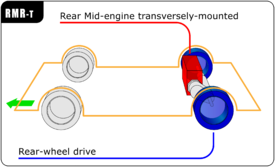
Back Motor trasero central y tracción trasera Spanish خودروهای موتور وسط عقب-محور عقب Persian 中置後驅 Chinese
This article needs additional citations for verification. (November 2011) |


In automotive design, an RMR, or rear mid-engine, rear-wheel-drive layout is one in which the rear wheels are driven by an engine placed with its center of gravity in front of the rear axle, and thus right behind the passenger compartment. Nowadays more frequently called 'RMR', to acknowledge that certain sporty or performance focused front-engined cars are also "mid-engined", by having the main engine mass behind the front axle, RMR layout cars were previously (until ca. the 1990) just called MR, or mid-engine, rear-wheel-drive layout), because the nuance between distinctly front-engined vs. front mid-engined cars often remained undiscussed.
In contrast to the fully rear-engine, rear-wheel-drive layout, the center of mass of the engine is in front of the rear axle. This layout is typically chosen for its favorable weight distribution. Placing the car's heaviest component within the wheelbase minimizes its rotational inertia around the vertical axis, facilitating turn-in or yaw angle. Also, a near 50/50% weight distribution, with a slight rear weight bias, gives a very favorable balance, with plenty of weight on the driven rear axle under acceleration, while distributing the weight fairly evenly under braking, thereby making optimal use of all four wheels to decelerate the car rapidly as well.
The RMR layout generally has a lower tendency to understeer. However, since there is less weight over the front wheels, under acceleration the front of the car can be prone to lift and still have understeer. Most rear-engine layouts have historically been used in smaller vehicles, because the weight of the engine at the rear has an adverse effect on a larger car's handling, making it 'tail-heavy', although this effect is more pronounced with engines mounted behind the rear axle.[1] It is felt that the low polar inertia is crucial in selection of this layout. The mid-engined layout also uses up central space, making it generally only practical for single seating-row sports-cars, with exception to a handful of 2+2 designs. Additionally, some microtrucks use this layout, with a small, low engine beneath a flat load floor above the rear wheel-wells. This makes it possible to move the cab right to the front of the vehicle, thus increasing the loading area at the expense of slightly reduced load depth.
In modern racing cars, RMR is a common configuration and is usually synonymous with "mid-engine". Due to its weight distribution and the favorable vehicle dynamics it produces, this layout is heavily employed in open-wheel Formula racing cars (such as Formula One and IndyCar) as well as most purpose-built sports racing cars. This configuration was also common in smaller-engined 1950s microcars, in which the engines did not take up much space. Because of successes in motorsport, the RMR platform has been commonly used in many road-going sports cars despite the inherent challenges of design, maintenance and lack of cargo space. The similar mid-engine, four-wheel-drive layout gives many of the same advantages and is used when extra traction is desired, such as in some supercars and in the Group B rally cars.
- ^ Hillier, Victor; Coombes, Peter (2004). Fundamentals of motor vehicle technology. Nelson Thornes. p. 9. ISBN 978-0-7487-8082-2.